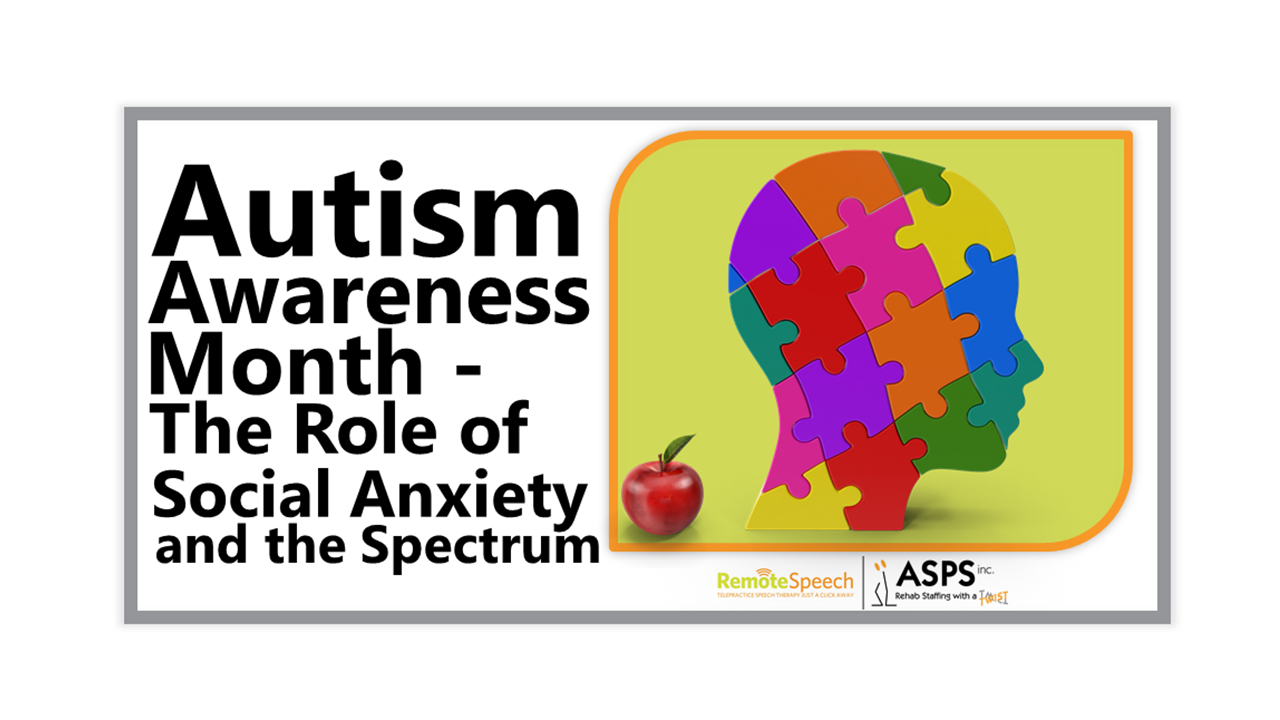
07
Apr
Autism Awareness Month – The Role of Social Anxiety and the Spectrum
The month of April is globally recognized as Autism Awareness Month, including “World Autism Awareness Day” on Friday, April 2, 2021. This year’s observance will be unlike any other, as it will run just two weeks after the one-year anniversary of the start of the Covid 19 pandemic. The anniversary of Covid 19 is accompanied by a diverse range of solemn reflections, as every aspect of society has been directly affected by the pandemic (some, more than others). Parents who have children with special needs are well-aware of the challenges faced, of migrating their child’s education to an online environment. While these transitions have had their own set of unique challenges and frustrations, the online migration has resulted in an “accidental” and welcome discovery – children with social anxiety are finding tremendous benefit from virtual interactions.
In part 1 of our series for Autism Awareness Month, we will take a look at an overview of anxiety and how it relates to children across Autism’s diverse spectrum. Then, we will explore a few welcome positive strategies for treating children with social anxieties in the not-so-social age of Covid 19.
WHY IT MATTERS – RATES OF AUTISM ARE RISING.
The prevalence rates of autism spectrum disorders (ASDs) have risen dramatically over the past several decades. In the United States, research suggests that one in every 91 children (one in 58 boys) is affected by Autism Spectrum Disorder. Research suggests that these prevalence rates are similar across the globe.ANXIETY PLAYS A MAJOR ROLE IN AUTISM SPECTRUM DISORDERS.
As noted by The National Center for Biotechnology Information: One factor linked to increased impairment beyond core ASD symptoms is the presence of anxiety [8]. Up to 80% of children with ASDs experience clinically significant anxiety [9–11], with high comorbidity rates for social phobia, generalized anxiety disorder (GAD), obsessive-compulsive disorder (OCD) and separation anxiety disorder (SAD) having been observed (30, 35, 37 and 38%, respectively) [9,10,12,13]. The presence of clinically significant anxiety is associated with compounded functional impairment beyond a single ASD diagnosis [14]. Anxiety comorbidity is associated with greater ASD symptom severity and concomitant impairments in psychosocial functioning [15–19]. For example, patients with ASDs and comorbid anxiety are at increased risk for displaying externalizing behavior problems [20], social avoidance [16,18–20], difficulties establishing/maintaining peer relationships, sleep problems and disruptions in family functioning [21,22]. Among youths with ASDs and anxiety, these problems are also present in school settings, with studies reporting increased disruptive behavior, noncompliance with teacher demands, and disengagement from peer-centered activities [23–27]. Or, more simply put, the presence of anxiety serves as a trigger in the large majority of children with an Autism Spectrum disorder. This anxiety oftentimes serves as the “root” cause for more complex and specific dysfunctions – resulting in more than one impairment. Plus, the tendency for multiple anxiety disorders leads to greater severity of symptoms. Anxiety begets anxiety, making the diagnosis more difficult. When anxiety is present in conjunction with autism spectrum disorders, it is linked to increased psychosocial, familial, behavioral, and academic impairment beyond the core autism symptoms.SOCIAL ANXIETY DISORDER – AN OVERVIEW:
STATISTICS:
Approximately 15 million Americans suffer from social anxiety disorder. Recent estimates indicate that 6 % of children and 12.1% of adolescents meet the criteria for this diagnosis. Social anxiety disorder starts as early as age 5 and peaks around age 12. When untreated, it runs a chronic course into adolescence and eventually adulthood. Children with the disorder tend to start noticing symptoms between the ages of 8 and 15, but if they hide how they are feeling, parents might not realize anything is wrong for some time.THE SIGNS:
Children with social anxiety disorder are extremely self-conscious about how they appear to others. There are two main types of social anxiety disorder. The first focuses on performance, with kids worrying about things like speaking in public or trying out for a team. The second type involves social situations in general — not just situations when a child is in the spotlight. Kids with this type of social anxiety may fear things like going to school, eating in public, using public restrooms, meeting new people, and even having conversations. Most people with more general social anxiety also experience anxiety about performing. The defining feature of social anxiety disorder includes marked fear or anxiety about one or more social situations in which the person might be subject to possible scrutiny by others. Examples include social interactions, being observed by others, and performing in front of others. Other symptoms of social anxiety disorder include the following:- The person feels that he or she will act in a way or show anxiety symptoms that will be negatively evaluated
- The social situations always trigger fear or anxiety (in children this can manifest as tantrums, clinging, crying, freezing up, or failure to speak)
- Social situations are avoided or endured with intense feelings of fear and anxiety
- The fear or anxiety is out of proportion to the actual threat
- The fear, anxiety, and avoidance lasts for 6 months or more
- Causes clinically significant distress in social, occupational (school), or other areas of functioning
- Dread of social events that can occur weeks in advance
- Excessive clinging to familiar people
- Tantrums when faced with anxiety-provoking social situations
- Blaming others for perceived social failures
- Physical symptoms: Blushing, racing heart, shaky voice, trembling, nausea, difficulty speaking
- crying
- throwing tantrums
- freezing
- clinging to a parent or caregiver
- shrinking
- not speaking in social situations





